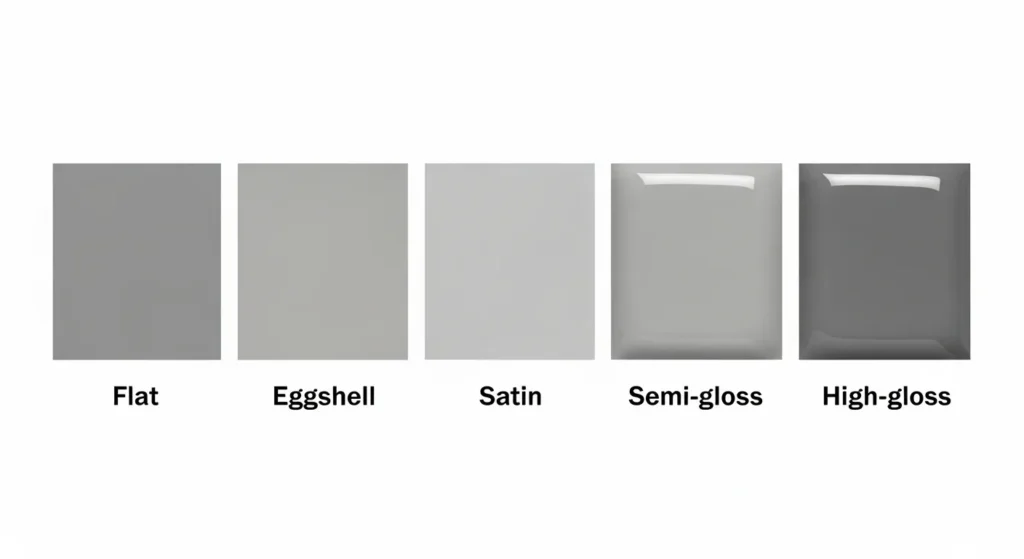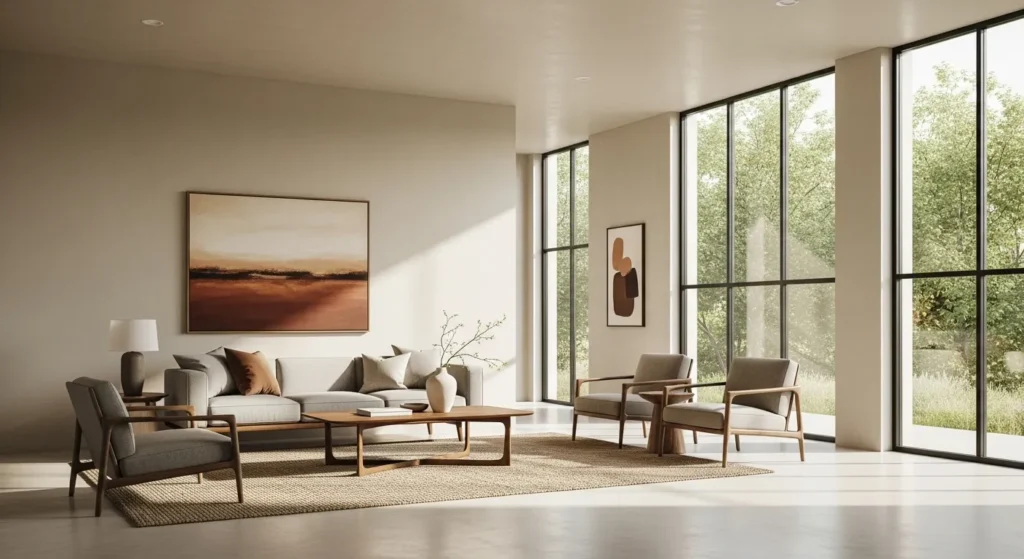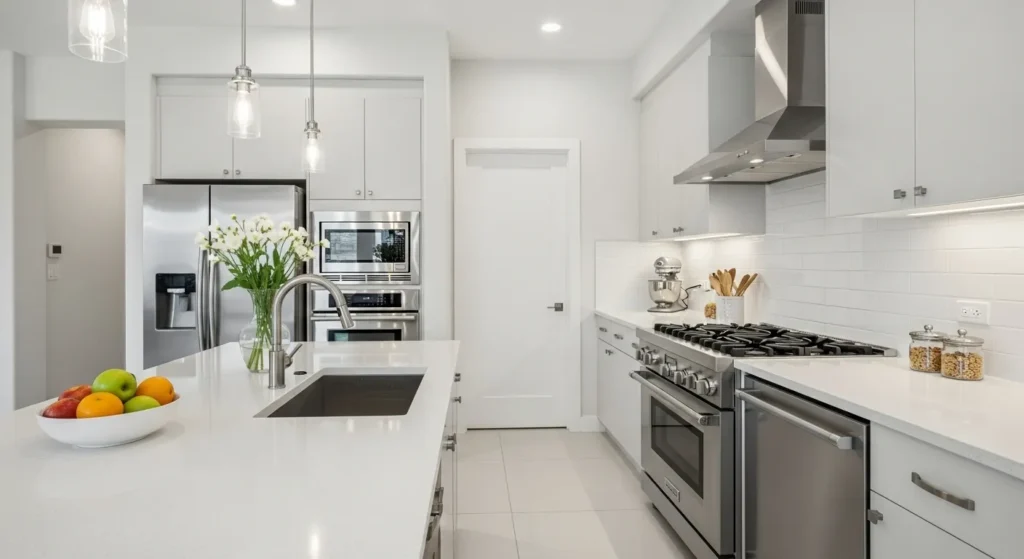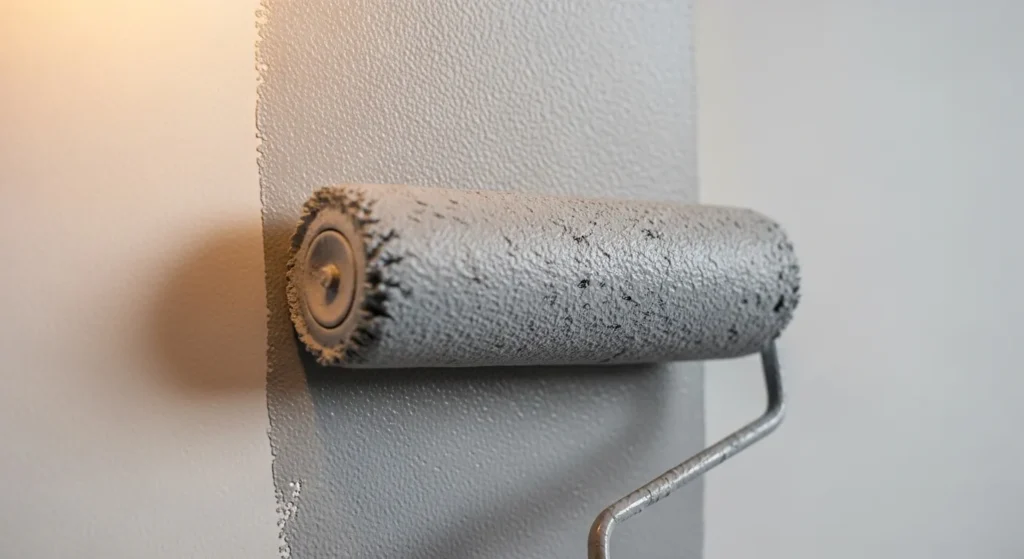Selecting the right paint finish can make or break your home’s appearance. The wrong choice leads to visible flaws, frequent touch-ups, and disappointment. This guide covers everything you need to know about paint finishes to make the best decision for each space in your home.
What Are Paint Finishes and Why They Matter
Paint finish refers to the level of shine or gloss on your painted surface once it dries. Each finish offers different benefits for durability, appearance, and maintenance. The finish you choose affects how light reflects off your walls and how well the paint holds up to daily wear.

Also Read: 15 Textured Wall Painting Techniques That Transform Any Room
The 5 Main Types of Paint Finishes
Flat (Matte) Paint Finish
Flat paint has no shine and provides the smoothest appearance. It hides surface imperfections better than any other finish.
Best for:
- Adult bedrooms
- Living rooms with minimal traffic
- Ceilings
- Low-traffic areas
Pros:
- Hides wall flaws and imperfections
- Provides rich, deep color
- No glare or reflection
- Most affordable option
Cons:
- Difficult to clean
- Shows scuff marks easily
- Not washable
- Requires frequent touch-ups
Eggshell Paint Finish
Eggshell offers a subtle, low shine similar to an actual eggshell. It provides better durability than flat paint while maintaining a soft appearance.
Best for:
- Adult bedrooms
- Dining rooms
- Home offices
- Living rooms
Pros:
- Hides minor imperfections
- Easy to touch up
- Better durability than flat
- Resists fading
Cons:
- Shows lap marks if not applied properly
- Limited washability
- Not ideal for high-moisture areas
Satin Paint Finish
Satin paint has a soft, pearl-like shine that reflects light gently. It offers good durability and moderate washability.
Best for:
- Family rooms
- Kids’ bedrooms
- Hallways
- Kitchen walls (not cabinets)
Pros:
- Good balance of durability and appearance
- Moderately washable
- Resists mildew
- Covers moderate imperfections
Cons:
- Shows brush strokes if applied incorrectly
- More expensive than flat or eggshell
- Can highlight wall imperfections in bright light

Semi-Gloss Paint Finish
Semi-gloss paint has a noticeable shine and offers excellent durability. It cleans easily and resists moisture well.
Best for:
- Bathrooms
- Kitchens
- Trim and moldings
- Doors and cabinets
- Kids’ playrooms
Pros:
- Highly washable
- Moisture resistant
- Very durable
- Easy to clean
Cons:
- Highlights surface flaws
- Shows brush marks easily
- Can look too shiny for some preferences
- Requires careful application
High-Gloss Paint Finish
High-gloss paint provides maximum shine and durability. It creates a mirror-like finish that’s extremely easy to clean.
Best for:
- Cabinet doors
- Furniture
- Front doors
- Window trim
- High-use areas needing frequent cleaning
Pros:
- Extremely durable
- Easy to scrub clean
- Moisture resistant
- Long-lasting finish
Cons:
- Shows every surface imperfection
- Requires perfect surface preparation
- Can look too formal for some spaces
- Most expensive option
Also Read: Color Psychology for Home: Boost Mood with Paint Colors
How to Choose the Right Finish for Each Room
Living Room Paint Finish
Choose eggshell or satin for living rooms. These finishes hide minor wall imperfections while allowing for occasional cleaning. Satin works better for homes with children or pets.
Bedroom Paint Finish
Flat or eggshell work best in bedrooms. Flat paint creates a cozy, intimate feel, while eggshell offers slightly better durability. Avoid glossy finishes in bedrooms as they can be too stimulating.
Kitchen Paint Finish
Use satin or semi-gloss for kitchen walls. These finishes resist cooking grease and clean easily. Semi-gloss is particularly good behind stoves and sinks where splashing occurs.

Bathroom Paint Finish
Semi-gloss or satin finishes work best in bathrooms. They resist humidity and mildew while cleaning easily. Semi-gloss is preferred in shower areas.
Kids’ Room Paint Finish
Satin or semi-gloss finishes are ideal for children’s rooms. They withstand crayon marks, fingerprints, and frequent cleaning without showing wear.
Hallway Paint Finish
Satin finish works perfectly for hallways. It handles the high traffic while maintaining an attractive appearance. The slight shine helps reflect light in narrow spaces.
Also Read: 25+ Stunning Accent Wall Ideas That Transform Any Room Fast
Factors to Consider When Choosing Paint Finish
Room Traffic Level
High-traffic areas need more durable finishes. Consider how often people touch the walls and whether the space gets heavy use.
Low Traffic: Flat, eggshell Medium Traffic: Satin High Traffic: Semi-gloss, high-gloss
Lighting Conditions
Natural and artificial light affect how paint finishes appear. Glossy finishes reflect more light, making rooms appear brighter but also highlighting flaws.
Wall Condition
Inspect your walls carefully before choosing a finish. Newer, smooth walls can handle glossier finishes. Older walls with imperfections need flatter finishes.
Maintenance Requirements
Consider how often you want to clean walls. Glossier finishes clean easier but show fingerprints more readily.
Personal Style Preference
Some people prefer the rich, sophisticated look of flat paint, while others like the practical benefits of glossier finishes.
Also Read: 15 DIY Wallpaper Hacks That Save You $500+ (Beginner Guide)
Common Paint Finish Mistakes to Avoid
Using Flat Paint in High-Traffic Areas
Flat paint shows scuffs and cannot be cleaned effectively. Avoid using it in hallways, kitchens, or kids’ rooms.
Choosing Semi-Gloss for Large Wall Areas
Semi-gloss can look too commercial or institutional on large wall surfaces. Reserve it for trim, doors, and accent areas.
Ignoring Surface Preparation
Glossier finishes require better surface preparation. Any imperfections will show through, especially with semi-gloss and high-gloss paints.
Mixing Finishes Randomly
Plan your finish choices throughout your home. Consistency creates better flow between rooms.
Tips for Applying Different Paint Finishes
Surface Preparation
Sand glossy surfaces lightly before painting. Fill holes and cracks completely. Prime stained or previously painted surfaces.
Application Technique
Use high-quality brushes and rollers. Apply thin, even coats rather than trying to cover in one thick application. Maintain a wet edge to avoid lap marks.
Drying Time
Allow proper drying time between coats. Glossier finishes often need longer drying periods.

Paint Finish Durability and Lifespan
Expected Lifespan by Finish Type
Flat Paint: 2-3 years in low-traffic areas Eggshell: 3-5 years with proper care Satin: 5-7 years in most conditions Semi-gloss: 7-10 years with regular cleaning High-gloss: 10+ years with maintenance
Signs It’s Time to Repaint
- Visible wear patterns
- Difficulty cleaning stains
- Fading or color changes
- Peeling or cracking
- Surface damage that cannot be repaired
Cost Comparison of Paint Finishes
Paint finish prices increase with gloss level. Flat paint costs least, while high-gloss costs most. However, more durable finishes may save money long-term through reduced maintenance and longer lifespan.
Budget Planning:
- Factor in primer costs for glossy finishes
- Consider professional application for semi-gloss and high-gloss
- Account for additional cleaning supplies for matte finishes
Environmental Considerations
Low-VOC Options
Most major paint brands offer low-VOC formulations in all finish types. These paints improve indoor air quality and reduce environmental impact.
Cleanup and Disposal
Glossier paints often clean up more easily, reducing water waste. Dispose of paint properly according to local regulations.
Professional vs. DIY Application
When to Hire Professionals
- Semi-gloss and high-gloss finishes on large areas
- Detailed trim work
- Textured walls requiring special techniques
- Time constraints or physical limitations
DIY-Friendly Finishes
Flat and eggshell finishes are most forgiving for beginners. Practice techniques on sample areas before starting full rooms.
Conclusion
Choosing the right paint finish depends on your specific needs, room function, and personal preferences. Start by assessing each room’s traffic level, lighting, and wall condition. Match the finish to the space’s requirements rather than choosing based on appearance alone.
Remember that you can mix finishes throughout your home. Use flat or eggshell in bedrooms, satin in living areas, and semi-gloss in kitchens and bathrooms. This approach gives you the best performance in each space while maintaining visual harmony.
Take time to prepare surfaces properly, especially for glossier finishes. The extra effort pays off in better appearance and longer-lasting results. When in doubt, test different finishes in small, inconspicuous areas before committing to entire rooms.
